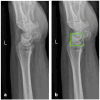Machine Learning-Aided Diagnosis Enhances Human Detection of Perilunate Dislocations
- PMID: 39815415
- PMCID: PMC11736725
- DOI: 10.1177/15589447241308603
Machine Learning-Aided Diagnosis Enhances Human Detection of Perilunate Dislocations
Abstract
Background: Perilunate/lunate injuries are frequently misdiagnosed. We hypothesize that utilization of a machine learning algorithm can improve human detection of perilunate/lunate dislocations.
Methods: Participants from emergency medicine, hand surgery, and radiology were asked to evaluate 30 lateral wrist radiographs for the presence of a perilunate/lunate dislocation with and without the use of a machine learning algorithm, which was used to label the lunate. Human performance with and without the machine learning tool was evaluated using sensitivity, specificity, accuracy, and F1 score.
Results: A total of 137 participants were recruited, with 55 respondents from emergency medicine, 33 from radiology, and 49 from hand surgery. Thirty-nine participants were attending physicians or fellows, and 98 were residents. Use of the machine learning tool improved specificity from 88% to 94%, accuracy from 89% to 93%, and F1 score from 0.89 to 0.92. When stratified by training level, attending physicians and fellows had an improvement in specificity from 93% to 97%. For residents, use of the machine learning tool resulted in improved accuracy from 86% to 91% and specificity from 86% to 93%. The performance of surgery and radiology residents improved when assisted by the tool to achieve similar accuracy to attendings, and their assisted diagnostic performance reaches levels similar to that of the fully automated artificial intelligence tool.
Conclusions: Use of a machine learning tool improves resident accuracy for radiographic detection of perilunate dislocations, and improves specificity for all training levels. This may help to decrease misdiagnosis of perilunate dislocations, particularly when subspecialist evaluation is delayed.
Keywords: artificial intelligence; computer vision; deep learning; lunate dislocation; perilunate dislocation.
Conflict of interest statement
Declaration of Conflicting InterestsThe author(s) declared no potential conflicts of interest with respect to the research, authorship, and/or publication of this article.
Figures



Similar articles
-
Automatic Detection of Perilunate and Lunate Dislocations on Wrist Radiographs Using Deep Learning.Plast Reconstr Surg. 2024 Jun 1;153(6):1138e-1141e. doi: 10.1097/PRS.0000000000010928. Epub 2023 Jul 17. Plast Reconstr Surg. 2024. PMID: 37467052
-
A deep learning-based algorithm for automatic detection of perilunate dislocation in frontal wrist radiographs.Hand Surg Rehabil. 2024 Sep;43(4):101742. doi: 10.1016/j.hansur.2024.101742. Epub 2024 Jun 21. Hand Surg Rehabil. 2024. PMID: 38909690
-
Lack of experience is a significant factor in the missed diagnosis of perilunate fracture dislocation or isolated dislocation.Acta Orthop Traumatol Turc. 2018 Jan;52(1):32-36. doi: 10.1016/j.aott.2017.04.002. Epub 2017 Nov 29. Acta Orthop Traumatol Turc. 2018. PMID: 29198546 Free PMC article.
-
Spectrum of carpal dislocations and fracture-dislocations: imaging and management.AJR Am J Roentgenol. 2014 Sep;203(3):541-50. doi: 10.2214/AJR.13.11680. AJR Am J Roentgenol. 2014. PMID: 25148156 Review.
-
Perilunate Injuries: Current Aspects of Management.Injury. 2021 Oct;52(10):2760-2767. doi: 10.1016/j.injury.2021.09.012. Injury. 2021. PMID: 34717826 Review.
References
-
- Cooney WP, Bussey R, Dobyns JH, et al. Difficult wrist fractures. Perilunate fracture-dislocations of the wrist. Clin Orthop Relat Res. 1987(214):136-147. - PubMed
LinkOut - more resources
Full Text Sources

